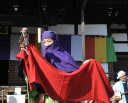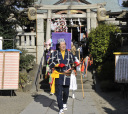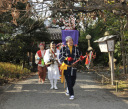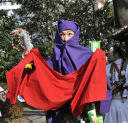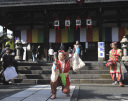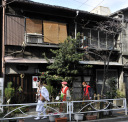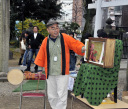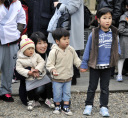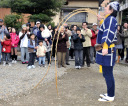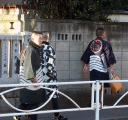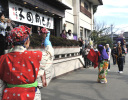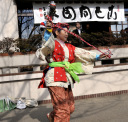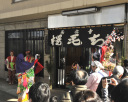Return to January
SUMIDA RIVER SHICHIFUKUJIN MEGURI and ASAKUSA ZATSUGEIDAN
|
|
Asakusa Zatsugeidan is a group based in Asakusa which study, practice, restore and reconstruct
the traditional shows and street performances of old Japan. Every year
on January 3, the troup reenact one of their repertoire "harukoma"
(cockhorse) in the occasion of Sumida River Shichifukujin Meguri. |
Tamonji Temple

Bishamonten |
The original temple of Tamonji was built in the Tentoku era (957-960) in
the middle of Heian period and moved to the present place by Tokugawa Ieyasu..
The gate to the main hall of the temple is the oldest building in Sumida-ku
constructed in 1772.
Bishamonten is the Hindu god of India Vaishravana. He is also known as
Tamonten. Bishamonten is the God of War and Warriors. The God is also considered
a god of healing. |
Shirahige Shrine

Jurojin |
The shrine was founded in 951 as a branch shrine of Shirahige Daimyojin in the country of Omi (Shiga prefecture).
Jurojin is the God of Longevity of China's Taoist god and is depicted as an old
man with a long white beard. |
|
Mukojima Hyakkaen Garden

Fukurokuju |
Mukojima Hyakkaen was built in the early 19th century by a wealthy merchant of Edo, Sahara Kiku-u. Hyakka-en means A Hundred Flowers Garden. The garden covers little more than 2 acres but is intensely planted with trees, deciduous shrubs, flowering bushes and a tunnel of bush clover. When the garden was first built, it featured 360 ume trees. Visitors can enjoy various flowers throughout four seasons.
Fukurokuju is a Japanese assimilation of one of the Chinese Three Star Gods.. The
appearance is resembled to the Chinese star god Shou. He is the God of
wisdom and longevity. |
|
Chomeiji Temple

Benzaiten |
Chomei-ji literally means a long life temple in Japanese. The name comes
from the legend that when the third Shogun of Tokugawa dynasty Tokugawa
Iemitsu had a stomach ache on his way back from falconry, he stopped at
the temple and took a medicine with water of the water well of the temple
and the stomach ache was soon healed. The name of the temple was titled
Chomei-ji since then.
Benzaiten is originally the Indian goddess Saraswati. Her Sanskrit name Sarasvati
Devi is "flowing water" thus Benzaiten is the goddess of everything
that flows - water, eloquence and music and money. |
|
Kofukuji Temple

Hotei |
Kofukuji is a beautiful Chinese style temple building. The temple belongs
to Japan's zen buddhism sect of Obakushu. Obakushu was introduced to Japan
by a Chinese buddhist Ingen (1592-1673). The style of the building reflects
Ming Dynasty Chinese buddhism temples.
Hotei is is the God of Contentment and is usually depicted with a bare potbelly
and carrying a bag. He was a real buddhism priest in Tang Dynasty China.
Hotei always carries a big bag on his back in which he puts charities he
received. |
|
Mimeguri Shrine

Daikoku |
|

Ebisu |
The shrine was founded during the period 1596-1615. The present shrine
buildings were constructed in Ansei era (1854-1859) in Edo period. Many
relics and buildings related to the Mitsui (zaibatsu) family are located
inside the precincts of the shrine. Also found are many stone plates in
which haiku and 31 syllable poems by famous kabuki actors and the literati
of Edo period are inscribed.
Daikoku is the God of Luck a great luck-bringer. His Shinto name is O-Kuni-Nushi-no-Mikoto
and the Master of the Great Land. He stands on two rice bales. He has a
sack of precious things on his back and holds a mallet of good luck.
Ebisu is a famous luck-bringer and is said to be the son of Daikoku. Ebisu is the God of Honest Dealing, the Patron of Fisherman, and the God of Food. He holdds a fishing rod in one hand and a large Tai (sea bream) fish in the other.
|
|
KADOZUKE
Kadozuke is going from house to house playing music, or showing artistic
accomplishments for money. We cannot see it today. It existed until around
the W.W. II.
Kadozuke at Kototoi Dango Store
Kadozuke at Chomeiji Sakuramochi Store
Kadozuke at Jimanmochi Store





